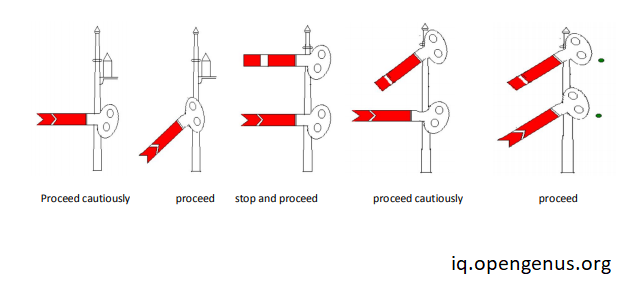
Open-Source Internship opportunity by OpenGenus for programmers. Apply now.
All of you must have travelled by train atleast once in your life. You may have observed that trains stop on stations for sometime and then depart from it, or it may stand upto hours due to some problems, sometimes trains also stops in midway between two stations. So have you ever wondered how the Locopilot (driver) of the train know when to stop the train, when to start the train and where to stop the train? So to answer this question let us think of a situation where you are driving a car or travelling in a car in a city where very busy traffic is there.
So to control the traffic on intersections you must have seen traffic signals, which indicate the road vehicles when to stop and when to go, by means of some colours such as Red(Stop), Yellow(Ready), Green(Go). This same rule with little deviation is applied for trains also i.e seeing signals and controlling the train accordingly. So today in this article we will discuss about the signalling system used by Indian Railways.
Indian Railways uses 3 types of Signals namely:-
- Static Signal
- Hand Signal
- Fog Signal
Static Signal
This is the main signal used by Railways to indicate the stop message or proceed message to the Locopilot. These signals are mounted on a pole or mast fitted at the side of the Railway track. These type of signals are further classified into 2 types namely:-
- Semaphore Signal
- Colour Light Signal
- Auxilliary Signal
Semaphore Signal
Semaphore Signal are those signals which have a mechanically actuating signal hand whose movement is observed as aspect of it. This type of signal is further classified into 2 types:-
TALQ - Two Aspect Lower Quadrant. In this signalling system only two aspects means two positions of the signal hand:- Horizontal and Lower Diagonal. The positions are indicated by following diagram.
When the hand of the signal is horizontal then it means stop and when this signal hand is lower this means proceed.
MAUQ- Multiple Aspect Upper Quadrant. In this signalling system more than two aspects are used. The movement of the signal hand is just opposite of TALQ signals i.e it moves only in upper direction. The position of this signal is indicated as following diagram.
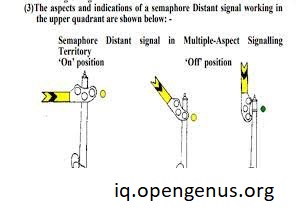
Hand in horizontal position means stop, upper diagonal position means caution and upper position means proceed. Here in the diagram please note that the stop position of the signal is termed as "Signal On" and other than stop position is termed as "Signal Off". We will be using these terms in upcoming discussions in this article. Both types of Semaphore Signals is very old and now discontinued.
Colour Light Signal
This type of signalling system is most commonly used in India and other countries as well. This is also known as Multi Aspect Colour Light Signal or MACLS according to Indian Railways terminology.This is very much similar to traffic signals you have seen on roads. They have 3 or 4 Colour LEDs mounted on a signal mast or pole. We define Red aspect of the signal as "Signal On" and other than Red aspect as "Signal Off". The different aspects of these signals are shown in the diagram.
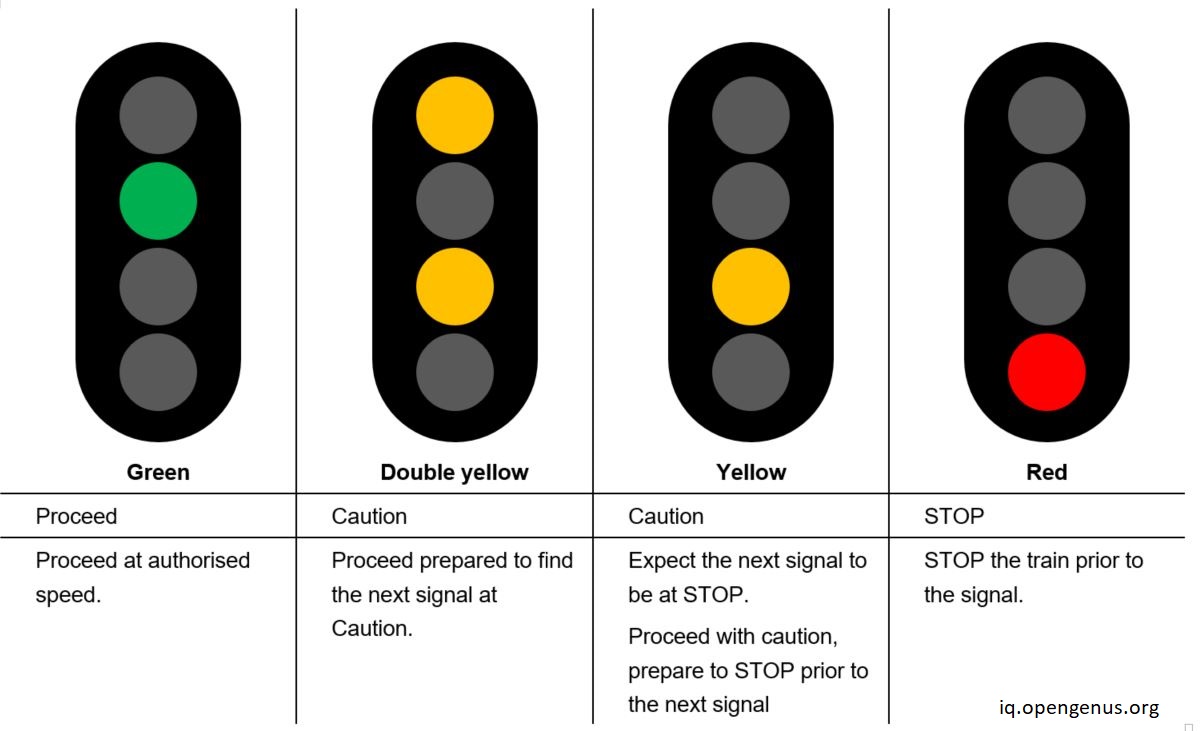
Now let us discuss different types of signals that fall under this category.
Starter Signal
This signal is mounted at the end of the platform area of the station. As the name suggests this signal is given to start a train from the platform. It 2 has aspects (yellow and red) if it is a loop line starter signal and 3 aspects (yellow, red and green) if it is a mainline starter signal. To identify this type of signal a white rectangular board is mounted at the bottom of signal in which "S-X" is writen in black font, here X is defined as the signal number of that particular signal. This signal is operated by Station Master of that particular station. Starter signal looks like follows.
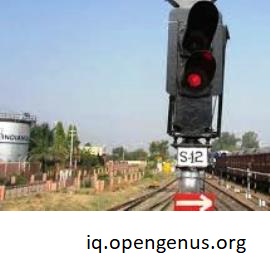
Intermediate Starter Signal
These signals are fitted after starter signal in junction stations where more than one route emerges. This signal informs about the route to be taken by the train. This signal appears same as starter signal but they are fitted with route indicator on top of it to inform the route the train needs to be taken. We will discuss more about route indicator in this article only.
Advanced Starter
These signals are also same in terms of appearance with Starter Signals. They act as a gateway to enter to Block Section (we have discussed about Block Section in my first article, go and check it out to know more). This signal is controlled by Station Master like any other signal present in station but it requires Line Clear to be taken from next station through the Block Instrument, without Line Clear Advanced Starter cannot be taken off (other than Red aspect) and it will not work (magic of interlocking system used in these signals).
Distant Signal
Distant Signals as the name suggests it is mounted at a distance before a stop signal to allow the train to slow down properly when approaching a signal in its 'On'(Red) position. They are mounted before 1km of upcoming signal and also give a glance about the position of it.This signal is being recognised by a white circular board with letter 'P' written in black ink written on it. Lets see how this signal warns about the aspect of upcoming stop signal.

The above diagram shows how it informs the Locopilot of the train about the upcoming signal. One thing is to be noted that this signal does not have a Red aspect as this is not a stop signal and is operated automatically according to stop signal's aspect ahead.
Home Signal
Home Signal as the name suggests acts as a gateway to Station section from Block section. The Station Section is considered as Home so the signal name is like that.
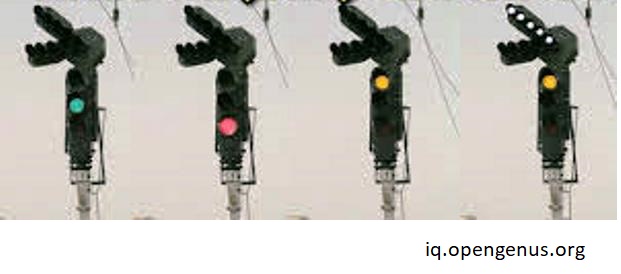
This signal can be recognised by series of LEDs mounted in a star pattern on top of it known as Route Indicator I have mentioned this in Intermediate Starter Signal. The Route Indicator indicates that which direction train is going to take when changing tracks. A Home Signal is being preceded by a Distant Signal 1000m before which we discussed above.
Automatic Signal
These signals are mounted in Automatic Block Section and are operated automatically according to the movement of trains. I have written an article about Block Section in Indian Railways in which I have discussed about Automatic Block Section and its working in it, if you want you can also check it out. The Automatic Block Signal is recognised as a signal in which there is a white circular board in which letter 'A' is written in Black Ink mounted on it. See the picture below.
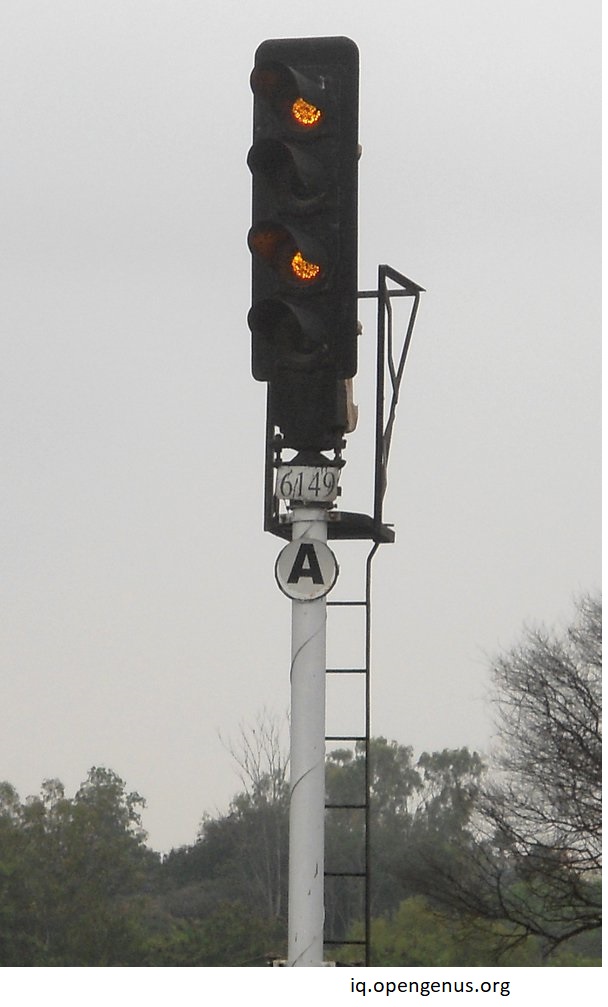
Semi Automatic Stop Signal
As the name suggests these type signals can be operated Manually as well as Automatically. They can be recognised as a Black circular board in which letter 'A' is illuminated in white is mounted on it. When the letter 'A' is glowing the signal works as Automatic Stop Signal and when the 'A' remains extinguished it works as a Manual Signal.
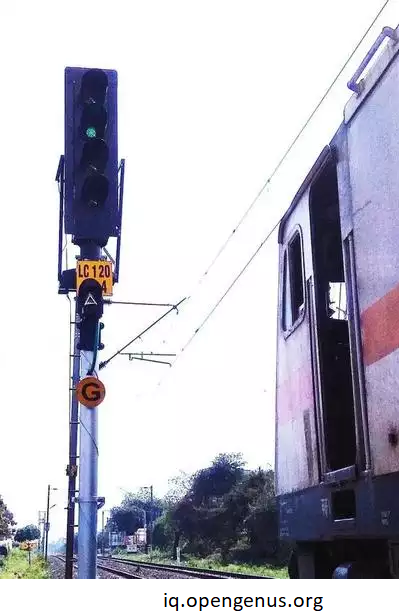
IBS Signal
IBS stands for Intermediate Block Signal. This stop signal is used to divide a long Block Section into two small Block Sections. This signal is recognised by a White circular board with 'IB' written in Black Ink mounted on it. This signal is being controlled by Station Master of rear station. A Talkback Telephone is mounted near the signal to enable the Locopilot to talk to the rear station's Station Master. The track is track circuited beyond the signal upto 400m distance as a measure to keep adequate distance to give Line Clear. This signal is also being preceded by a Distant Signal 1000m before like Home Signal.The signal looks as follows.

Auxiliary Signals
Auxiliary Signals are used to assist the Locopilot of the train in some special condition such as shunting. There are following types of auxiliary signals.
Shunt Signal
As the name suggests Shunt Signal is used to assist a Locopilot of a train or locomotive during a shunting operation. It is used to give permission for shunting within the station section i.e between Home Signal and Advanced Starter Signal of that station.

It can be recognised by its very short mast, a rectangular white board specifying its number as 'SH-XX'(XX specifies its 2 digit number) in black ink. This signal has 3 lights mounted in a triangular pattern.
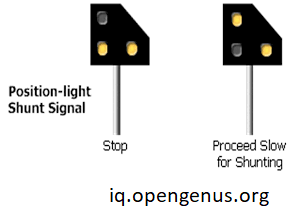
If lower 2 lights are glowing it means shunting is not allowed and if the upper light is glowing with lower right side light it means shunting is allowed with speed limit of 15Kmph.
Gate Signal
This signal is mounted before a level crossing gate so its name is Gate Signal. It protects the trains from passing a level crossing gate at open position. This signal is Red when level crossing is open for road users and Green when level crossing is closed and locked securely for the road users. The signal can be recognised by a yellow circular board in which letter 'G' is written in black ink.

This signal is being preceeded by a distant signal before 1000m to ensure proper braking by the train to stop at Gate Signal when it is showing red aspect.
Calling On Signal
This type of signals are required when there is a need for admiting a locomotive and train into the station section when it is impossible to give home signal due to occupancy of the line or the signal is defective. This signal is a single aspect signal mounted on the mast of home signal and it is recognised by a white circular board in which letter 'C' is written in black ink. This signal has only one small yellow light that glows when Calling On Signal is given, otherwise it remains in extinguished condition.
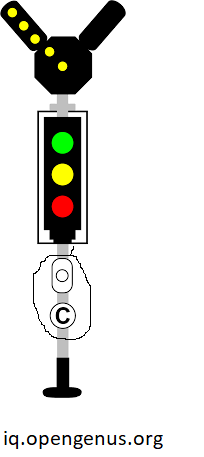
The part I have circled in black in the above picture shows a Calling On Signal mounted on a Home Signal.
Reapeating Signal
This is also an auxiliary signal which is mounted on that place where the main signal could be obstructed by some natural barriers or due to a curve on tracks. This signal could be recognised by a black circular board with illuminated 'R'. This signal does not have any red aspect. By seeing this signal we can know the aspect of signal being repeated. Example if the signal is yellow the main signal is red, if it is double yellow then main signal is either double yellow or yellow and if repeating signal is green then main signal is green.
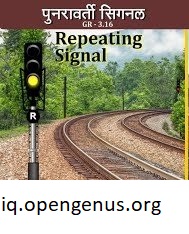
Co-acting Signal
This type of signal is used when a signal is not visible due to overbridge and this type of signal have 2 signals mounted on a same pole which shows same aspects simultaneously.
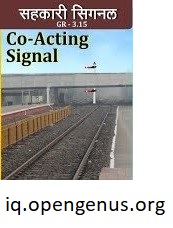
Hand Signal
The signal that is operated by hand and can be carried by hand are hand signal. These type of signals consist of flags, torches and detonators.
Flags
Flags are used to exchange signals by locopilots, guards and other staff directly responsible for operation of the train. Two colour flags red and green are used in this process.
Color light torches
In place of flags colour light torches are used during night when flags cannot be used.
Detonators
These are small explosives that is carried by running staff and is mounted on tracks whenever there is fog or other low visibility condition. When a rolling stock steps over detonators they explode causing loud noise which alerts locopilots for abnormal condition. Due to that application they are also called as fog signals.
I hope you have learnt something new by reading this article on OpenGenus.
